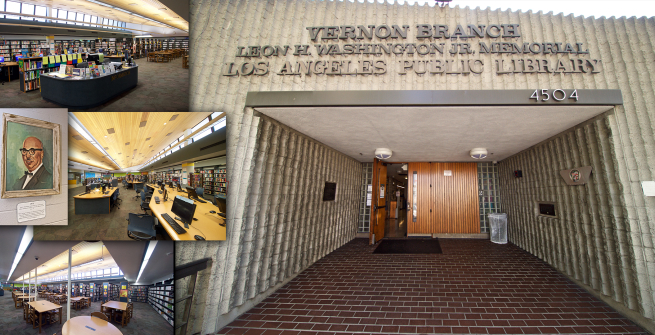The Vernon - Leon H. Washington Jr. Memorial Branch, located on Central Avenue at 45th Street, is one of the oldest branches in the Los Angeles Public Library system. There is an incredible amount of history that took place within a two-mile radius of the library. The area was an entertainment hub in the early to mid-twentieth century, and the library holds many stories from the community's history. These include the memories of people who grew up near the library, remembrances of musicians who played along Central Avenue in the mid-twentieth century, the story of a hotel that shifted the center of the city's black community, and tales of cars racing against airplanes at a nearby sports venue, to name but a few. The library's resources of books, newspapers, maps, and especially photos help us unpack some of this history.
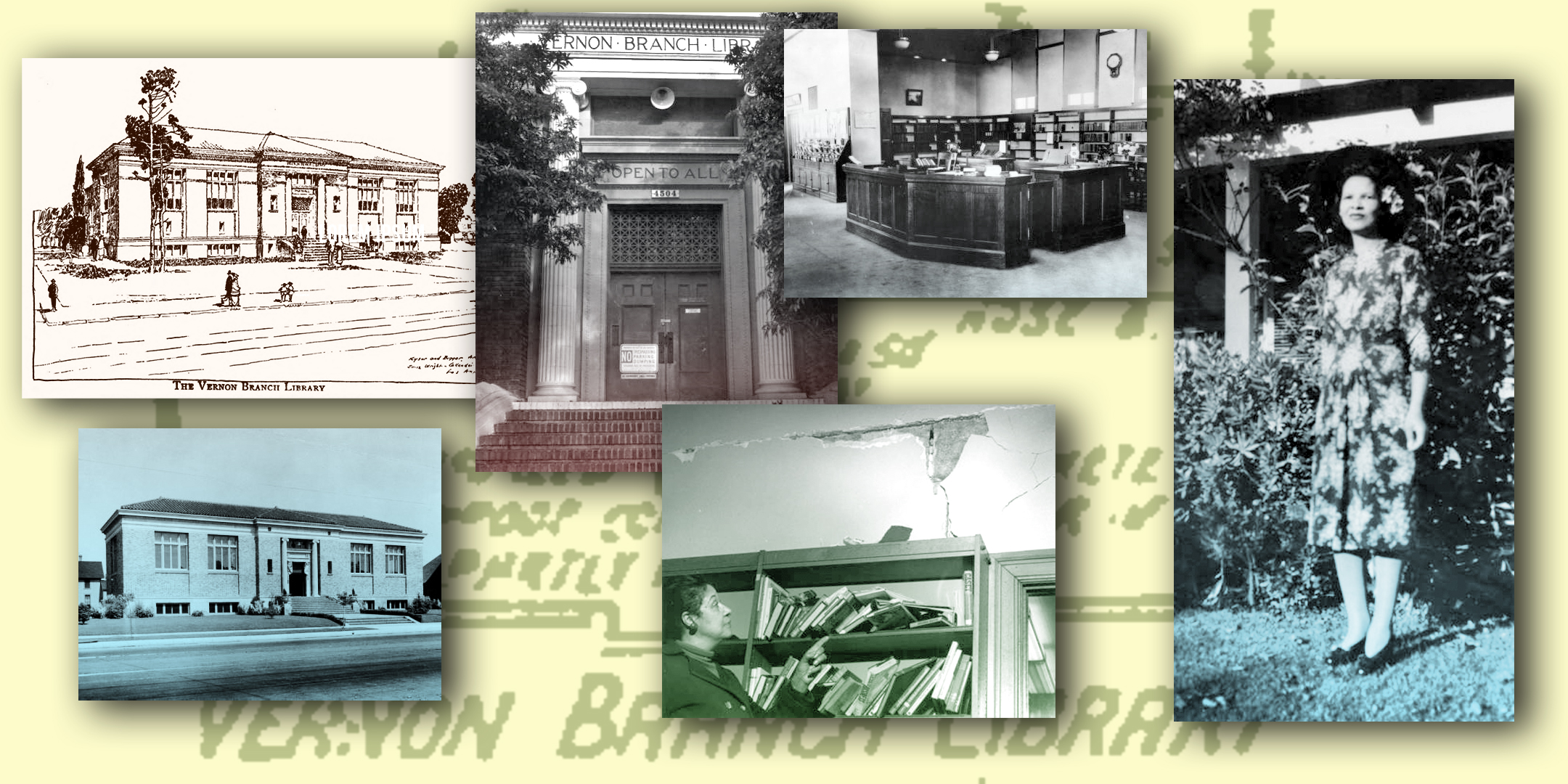
Within a few blocks of your home would be a good library that was open until eight o'clock. Families would go there to study together and read all the books that were written by black writers, which had to be distributed by hand to the people—Jazz pianist and composer Horace Tapscott, Songs of the Unsung, 2001
The Vernon Branch of the Los Angeles Public Library has quite a history itself. Library service in the area started in 1901 with a small delivery station. Due to its popularity and the commitment from the community, it became a branch library in 1902, located in rented quarters on the corner of Vernon and Central. The Vernon Branch was initially given that name to differentiate it from the other branch library on Central Avenue (north of Adams Blvd) called the Central Avenue Branch, which opened in late 1901.
The small Vernon Branch in rented quarters held its own during its early years, often checking out as many books as the Carnegie branches in Hollywood and Vermont Square. Andrew Carnegie visited Los Angeles in 1911 and offered $210,000 to build six libraries. As a result of his offer, $35,000 was allotted to fund a building for the popular Vernon Branch. The Carnegie Library on Central Avenue at 45th Street, designed by architects Charles Kysor and Charles Biggar in an Italian Renaissance style, opened in September 1915. Like several other Los Angeles Carnegie libraries, it had an outdoor reading room when it opened. The library publicized the branch as "a spacious building, rich in coloring and with a beautifully tiled entrance, reaching a community that mingles industrial and business elements with many residences and a large representation of school children." Sadly, Vernon's Carnegie building was damaged and demolished in the 1971 San Fernando earthquake. Bookmobile service and a temporary library filled in until the new Vernon - Leon H. Washington Jr. Memorial Branch, designed by Mathew Lapota & Associates, opened in 1975.
Many wonderful librarians have worked at Vernon over the years, but one librarian's presence continues to be felt. Miriam Matthews, the first accredited African American librarian at the Los Angeles Public Library, took over the branch in 1934 after leading the Helen Hunt Jackson Branch for five years. She had a very successful book club at the Helen Hunt Jackson Branch, which she also launched at Vernon. Literary figures, including Arna Bontemps and Langston Hughes, gave book reviews and spoke at the Vernon Branch. In fact, Ms. Matthews invited numerous community members to give book reviews at Vernon, including newspaper editor Charlotta Bass, Helen Wheeler Riddle (the first African American female law school graduate of USC), Dr. Ruth Temple, and Edgar J. Johnson of the Golden State Mutual Life Insurance Company. Ms. Matthews led the Vernon Branch from 1934-44 and made a huge impression (learn more about her life here). She also started building a collection at the library of books devoted to African American history and literature that continues to grow today. A 1934 report from the Vernon Branch noted that the books were shelved in a special section, and it was to the "evident satisfaction of many patrons who are now able to find a desired book on the subject without assistance from the staff."
Central Avenue
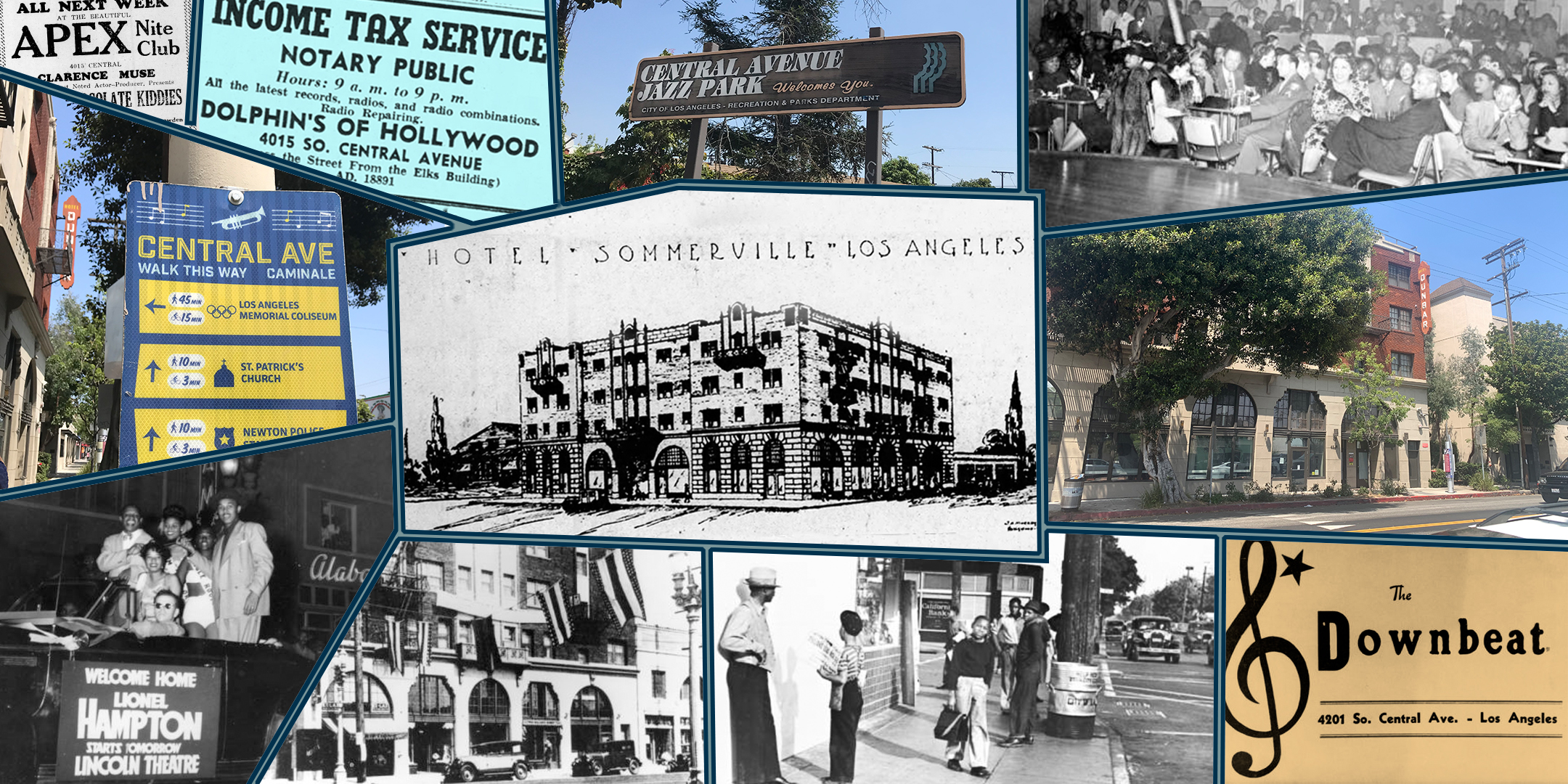
I've been to all those places that are supposed to be swinging, like Kansas City, Chicago, and New York, and all those places. But they didn't swing like Central Avenue.—Jazz pianist and bandleader Fletcher Smith in Central Avenue Sounds
This entire blog post could easily be devoted to resources related to the musicians and music venues present during Central Avenue's heyday. The 1989 book Central Avenue Sounds is excellent jumping off point for learning about the thriving community along Central Avenue from the 1920s up to the mid-1950s. A majority of the book features oral histories of those who worked on and/or lived near Central Avenue during this time. Two lavishly illustrated books offer an overview of the Central Avenue music scene, Black Music History of Los Angeles - It's Roots: 50 Years in Black Music and Central Avenue - Its Rise and Fall, 1890-c. 1955 (which also includes a driving tour of the community with musician Florence "Tiny" Brantley). Several musicians, including Buddy Collette, Dexter Gordon, Red Callendar, Etta James, and Barry White, wrote autobiographies about living or growing up in the community surrounding the Vernon Library. Two autobiographies were especially vivid for their description of the community—Songs of the Unsung: The Musical and Social Journey of Horace Tapscott and Raise Up Off Me: A Portrait of Hampton Hawes.
Central Avenue from 42nd Street to Vernon Avenue was packed with clubs, restaurants, stores, and the famed Dunbar Hotel. Dolphin's of Hollywood record shop/radio store/record label even had a DJ spinning records in the store's window facing Central Avenue. During this time, the Vernon Library was just a few blocks further south down Central Avenue at 45th Street. Central Avenue was filled with music and entertainment, especially after the Hotel Somerville was opened in 1928 (it was renamed the Dunbar Hotel in 1929). The hotel was built by local civil rights advocates John and Vada Somerville in hopes of persuading the NAACP to hold their convention in Los Angeles. Check out Bound for Freedom: Black Los Angeles in Jim Crow America for the incredible story of the origins of the hotel that became the center of Black Los Angeles.
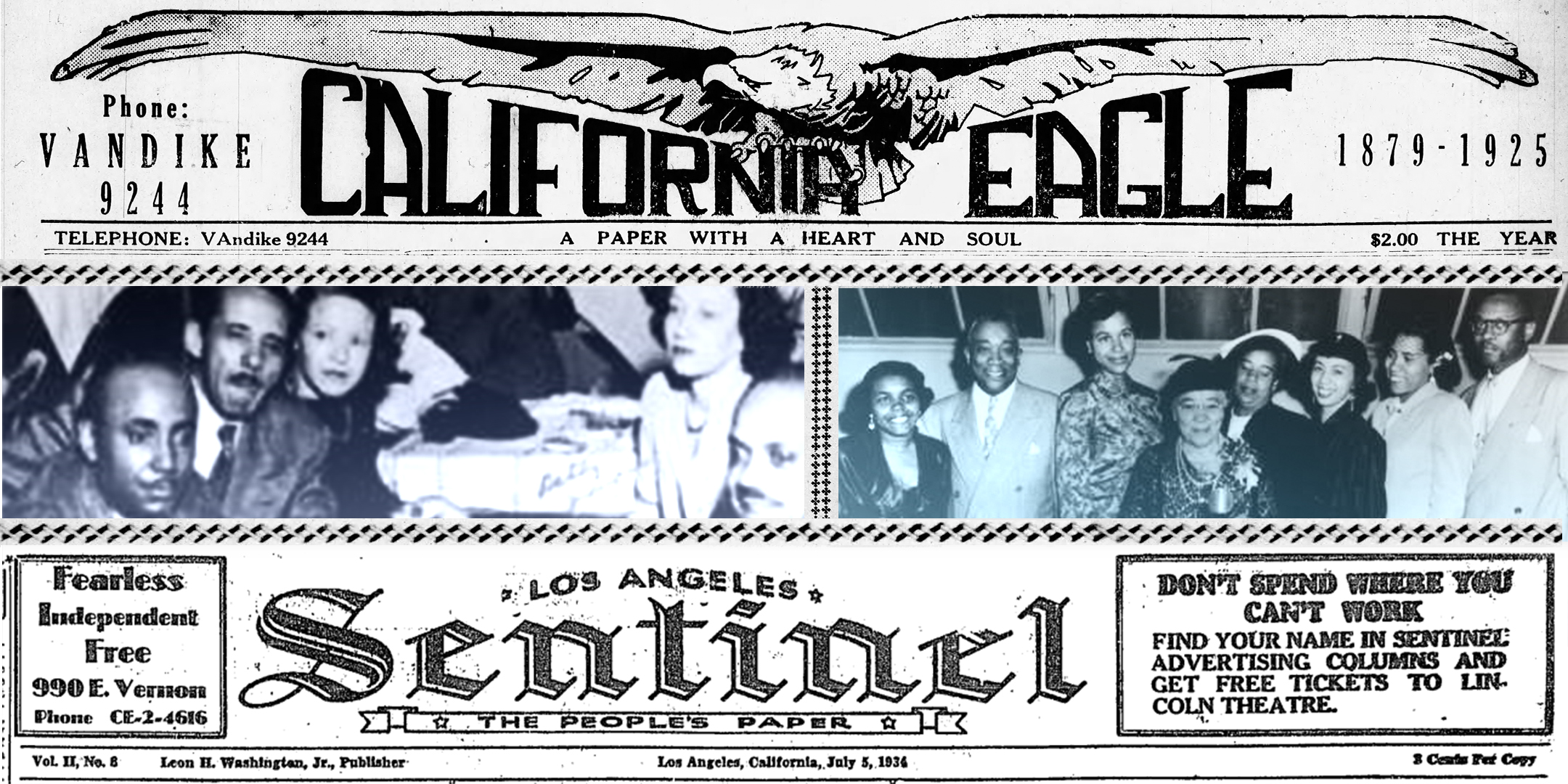
The Hotel Somerville's opening was covered in the California Eagle, one of the leading African American newspapers in Los Angeles, which was at the time published by Charlotta Bass. (Learn more about the incredible Mrs. Bass here.) The newspaper's office moved to various locations on Central Avenue over the years, but spent many years near 40th and Central, just up the street from the library. Leon H. Washington Jr., the Vernon Library's namesake, worked at the California Eagle before starting his own newspaper, Los Angeles Sentinel, in 1933. "Don't Spend Where You Can't Work" appeared on the newspaper's masthead, encouraging Sentinel readers not to buy goods from stores that would not hire African American employees. The Sentinel's office moved its location over the years but was generally short distances from Central and Vernon. Both newspapers covered the goings on in the community. You can access the archives of both the California Eagle (the library's coverage dates from 1914-1964) and Los Angeles Sentinel (the library's coverage dates from 1934-2010) for free with your Los Angeles Public Library library card. You can also read digitized issues of Central Avenue News (1910-1911) on the library's website.
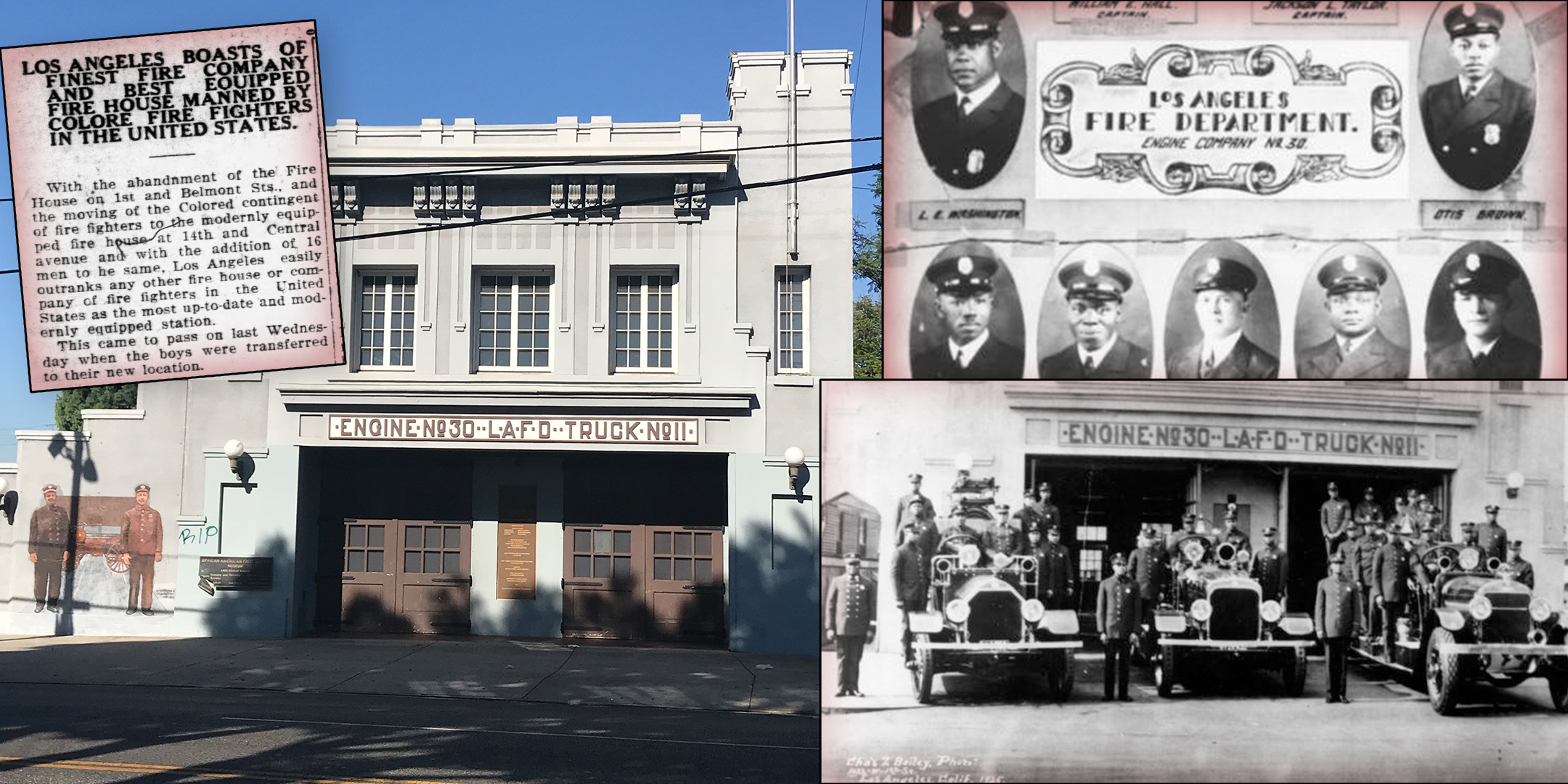
In addition to finding the various locations of the California Eagle and Los Angeles Sentinel offices over the years, the library's digitized city directories (available here) offers the opportunity to find the former locations of clubs and businesses along Central Avenue and/or in the nearby community. One location that you can still visit today should not be missed. During Central Avenue's busiest years, there were two fire stations in the community, Station 14 (at Central & 34th Street) and Station 30 (at Central & 14th Street). Due to the segregation of the Los Angeles Fire Department, they were the only stations where African American firefighters were able to work. The Los Angeles Sentinel and California Eagle reported on the firefighters's plight. Thanks to the efforts of former firefighter (and lawyer) Arnett Hartsfield Jr., the former LAFD Station 30 now serves as the African American Firefighter Museum and tells the difficult history of the Los Angeles Fire Department's desegregation.
Education: Music and Otherwise
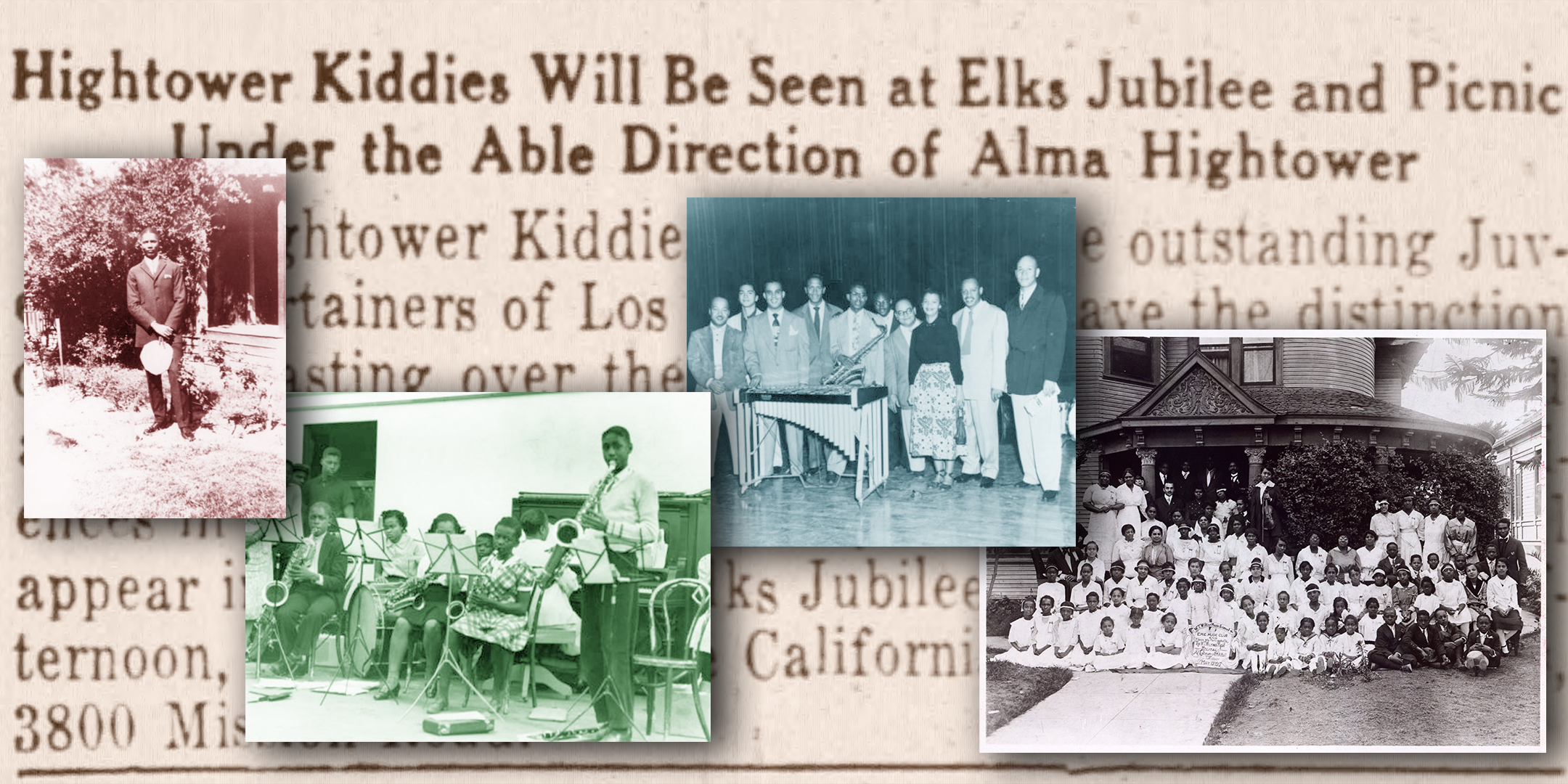
...all different kinds of people telling you different things about the same thing [playing music] and their approaches to it and how many ways it can be done.—Jazz pianist and composer Horace Tapscott talking about the vast number of mentors in the community, Central Avenue Sounds
Most of the books I checked out about Central Avenue focus on the musicians, and the musicians spoke at length about their mentors and music instructors who lived in the community. The African American Musicians Local 767, located on Central Avenue near 17th Street, served as a community center/social club where local and traveling musicians gathered. Young aspiring musicians in the neighborhood, including Buddy Collette and Horace Tapscott, soaked up the advice of older musicians who hung out at the Local 767.
One of the earliest African American music teachers mentioned in the books and newspapers I consulted was W.T. Wilkins. Professor Wilkins, who taught music as far back as 1915, had a music school on Newton near Hooper and later at 1325 S. Central. Samuel Browne, a student of Prof. Wilkins, went on to become a much-beloved music teacher at nearby Thomas Jefferson High School (the auditorium of the school is still named after Mr. Browne). Mr. Browne, who lived on 43rd Place, was the musical instructor praised most often in musician's oral histories and/or autobiographies. His students included Dexter Gordon, Horace Tapscott, Art Farmer, Big Jay McNeely, Chico Hamilton, Jackie Kelso, and Ernie Andrews, among many more. Other private music teachers mentioned in autobiographies and oral histories include Lloyd Reese and Alma Hightower. Mr. Reese taught students, including Dexter Gordon and Buddy Collette, out of his home on Jefferson Blvd near Maple, while Alma Hightower rehearsed with her pupils in Ross Snyder Park near Jefferson High School. Don't miss Steven L. Isoardi's The Dark Tree for more about Samuel Browne and musical mentorship in the community.
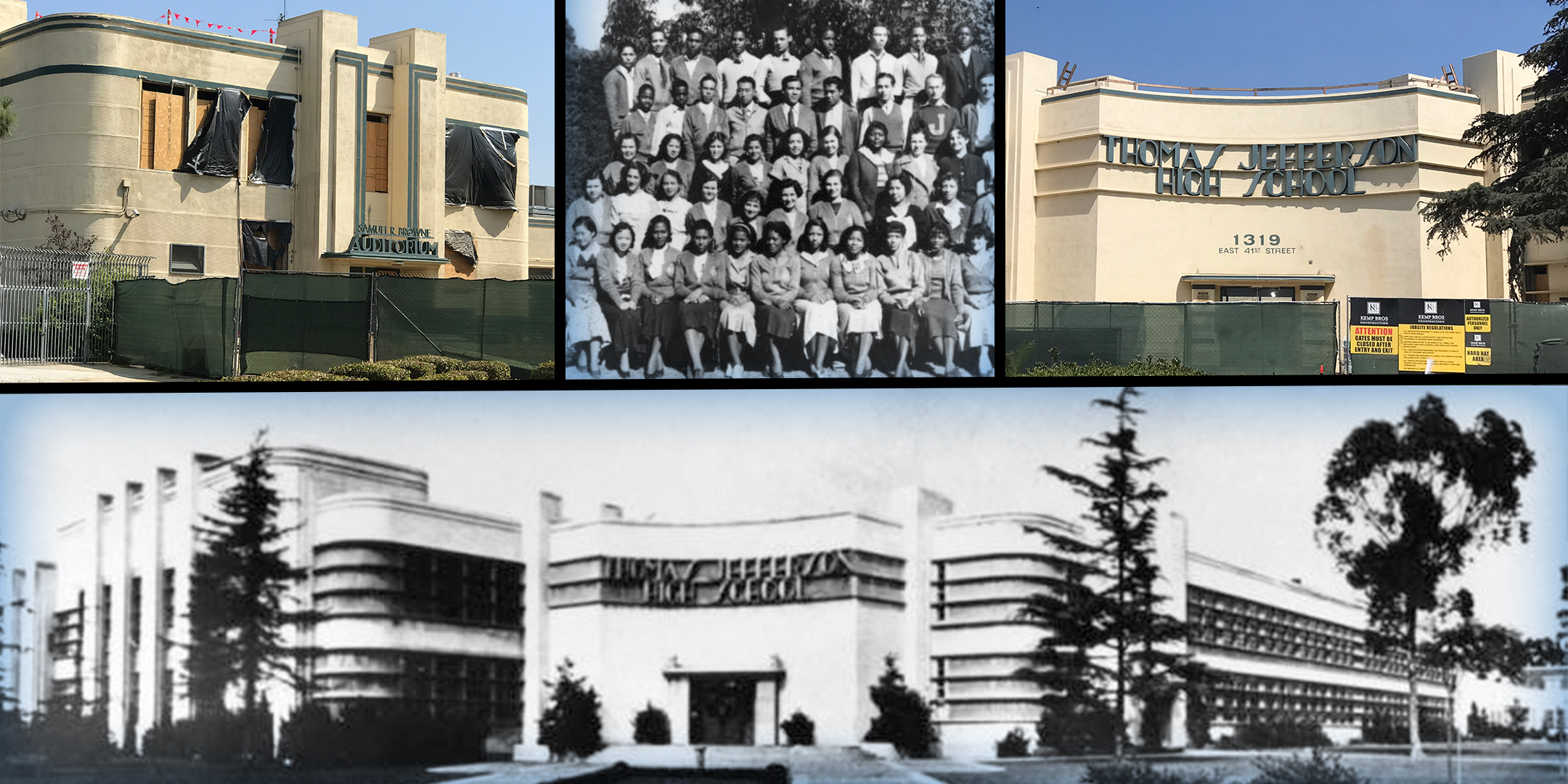
Thomas Jefferson High School dates back to 1916. The original campus buildings were heavily damaged in the 1933 Long Beach earthquake, and students were taught in tent bungalows while the campus was rebuilt. The beautiful 1936 rebuild, designed by Stiles O. Clements, features what Robert Winter and David Gebhard called "monumental Streamline Moderne at its best." The campus is currently being renovated, but you can still see the Samuel R. Browne Auditorium behind the fencing.
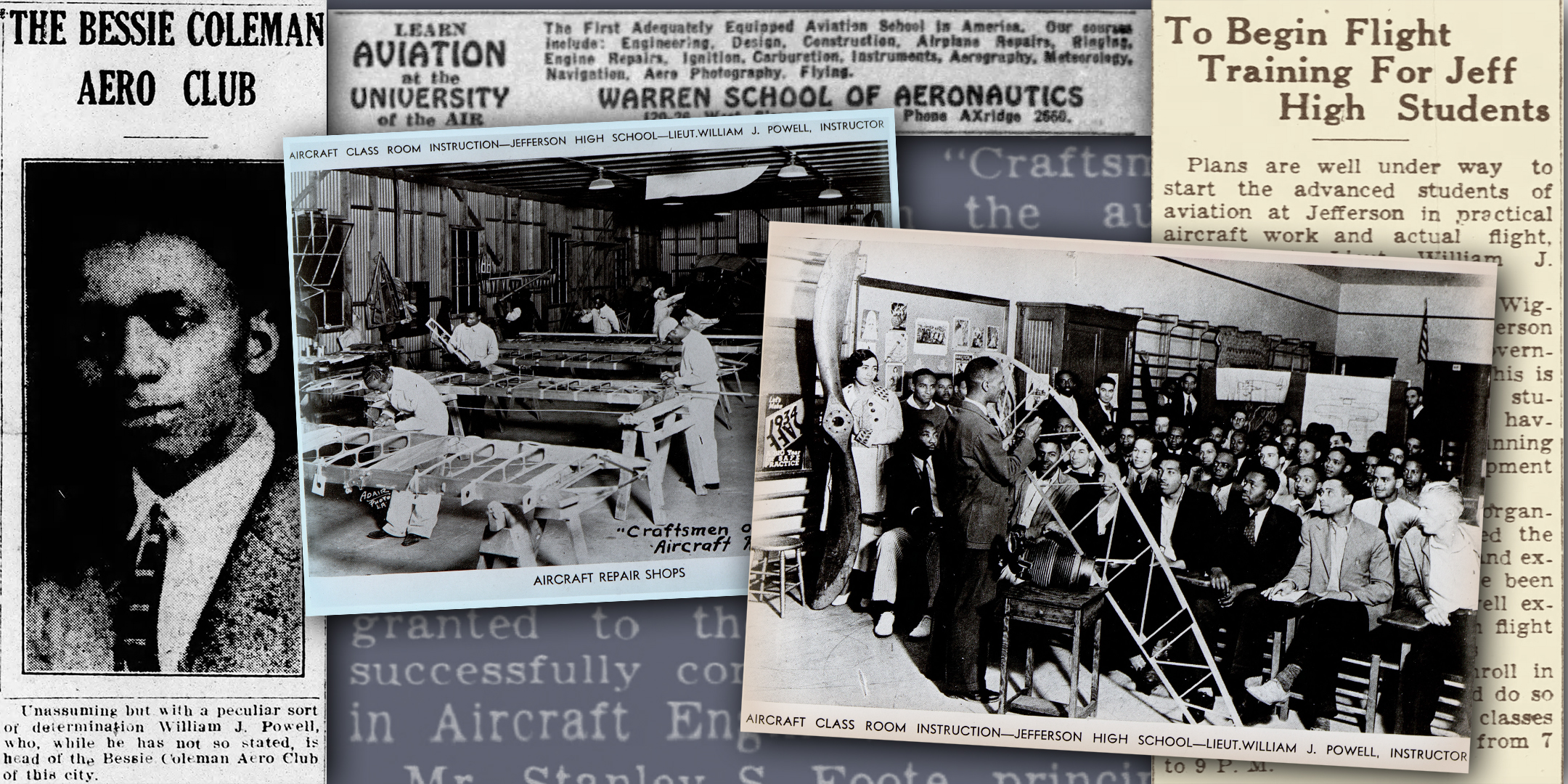
There is a better job and a better future in aviation for Negroes than in any other industry, and the reason is this: aviation is just beginning its period of growth, and if we get into it now, while it is still uncrowded, we can grow as aviation grows.—Lieutenant William J. Powell, Black Wings (1934)
Jefferson High's musical history and beautiful architecture may be well-known, but the school is also part of aviation history in Los Angeles. William J. Powell, an African American World War I veteran from Chicago, moved to Los Angeles in 1928 to attend the Warren School of Aeronautics on Slauson Avenue near Main Street. While still at the school, he started the Bessie Coleman Aero Club, named after the first African American person to earn a pilot's license (Sadly, Ms. Coleman was a passenger in a tragic plane accident in 1926). California Eagle described the club as "giving those who are interested in Aviation [sic] a chance to satisfy their desire to learn everything about it."
Following his graduation from the Warren School of Aeronautics, pilot and aeronautical engineer William J. Powell began teaching aeronautics to others. Jefferson High School and nearby Lafayette Junior High were both locations for adult evening aviation classes taught by Mr. Powell. He enthusiastically promoted aviation to the African American community, encouraging them to become pilots, airplane mechanics, and aeronautical engineers. An organization called Craftsmen of Black Wings was composed of students from Powell's aviation classes and met at Ross Snyder Park or at members' homes. The California Eagle and Sentinel newspapers covered Powell and Black aviation in Los Angeles. In 1934, Powell published a semi-autobiography about his aeronautics career entitled Black Wings. His book, along with several other books and documentaries about the Black Wings, can be found at the Los Angeles Public Library. One documentary, Flyers in Search of a Dream, has incredible footage of William J. Powell in the 1930s, as well as an interview with Marie Dickerson Coker, a former performer at Sebastian's Cotton Club, turned aviatrix, who flew with William J. Powell.
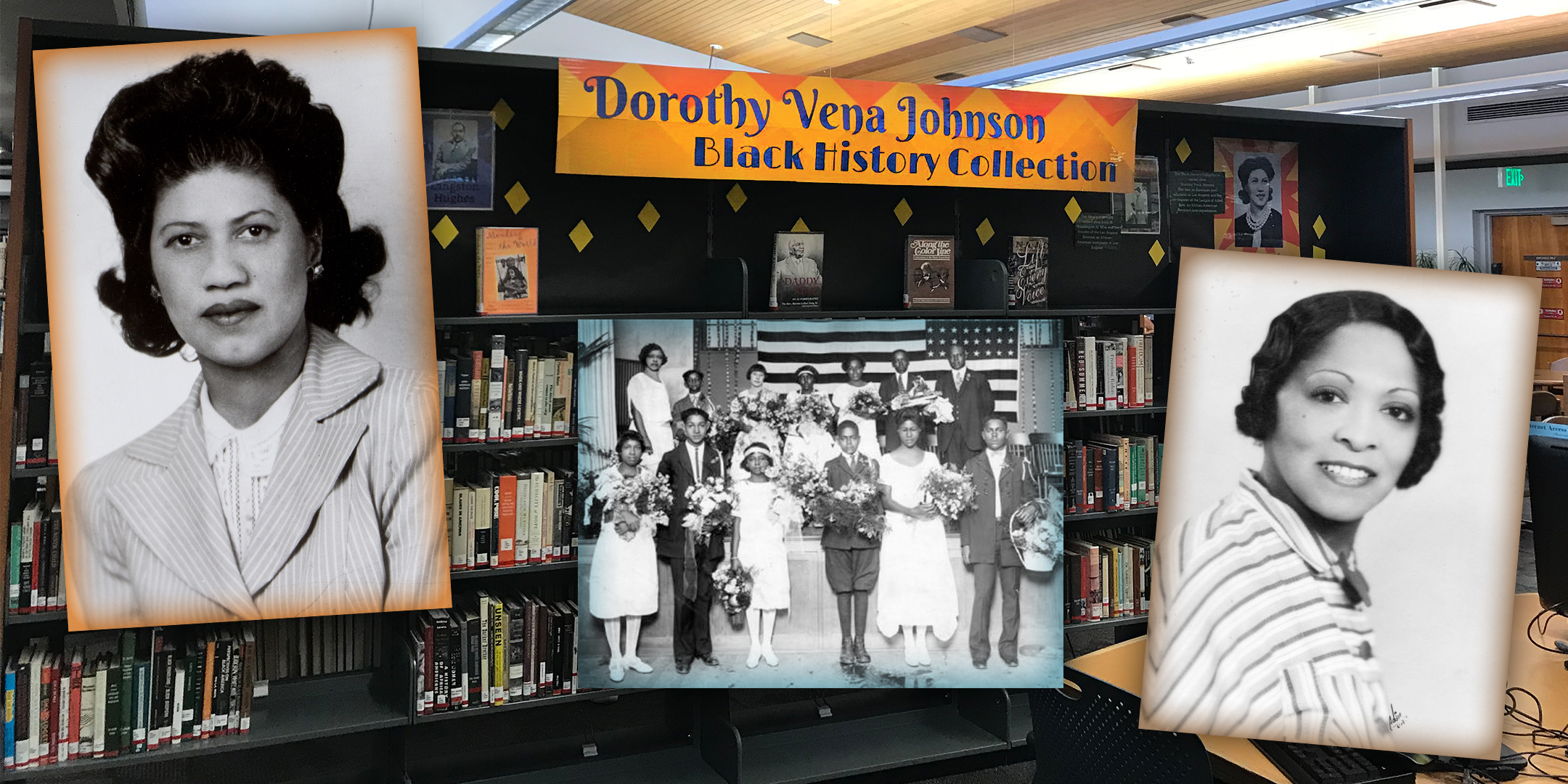
Bessie Bruington Burke, the first African American teacher in the Los Angeles Unified School District, taught at nearby Holmes Elementary School. She also became the first African American principal at LAUSD, advancing to that position at Holmes Elementary in 1918 before moving on to nearby Nevins Elementary School in 1939. Another notable African American teacher was Dorothy Vena Johnson, for whom the Vernon Branch's amazing Black History Collection was named. Mrs. Johnson taught at LAUSD for 40 years. (In 1936, Mrs. Johnson even took her Ascot Elementary class to Dycer Airport to meet William J. Powell.) The Black History Collection was started by librarian and historian Miriam Matthews while she was in charge of the Vernon Branch (1934-44). In 1971, the League of Allied Arts gave a large donation to help build the collection, which continues to grow today. The League of Allied Arts, started in 1939 by Dorothy Vena Johnson and social worker Juanita Miller (wife of civil rights lawyer and former California Eagle owner and editor Loren Miller), was founded to support and promote the arts in Los Angeles.
Art
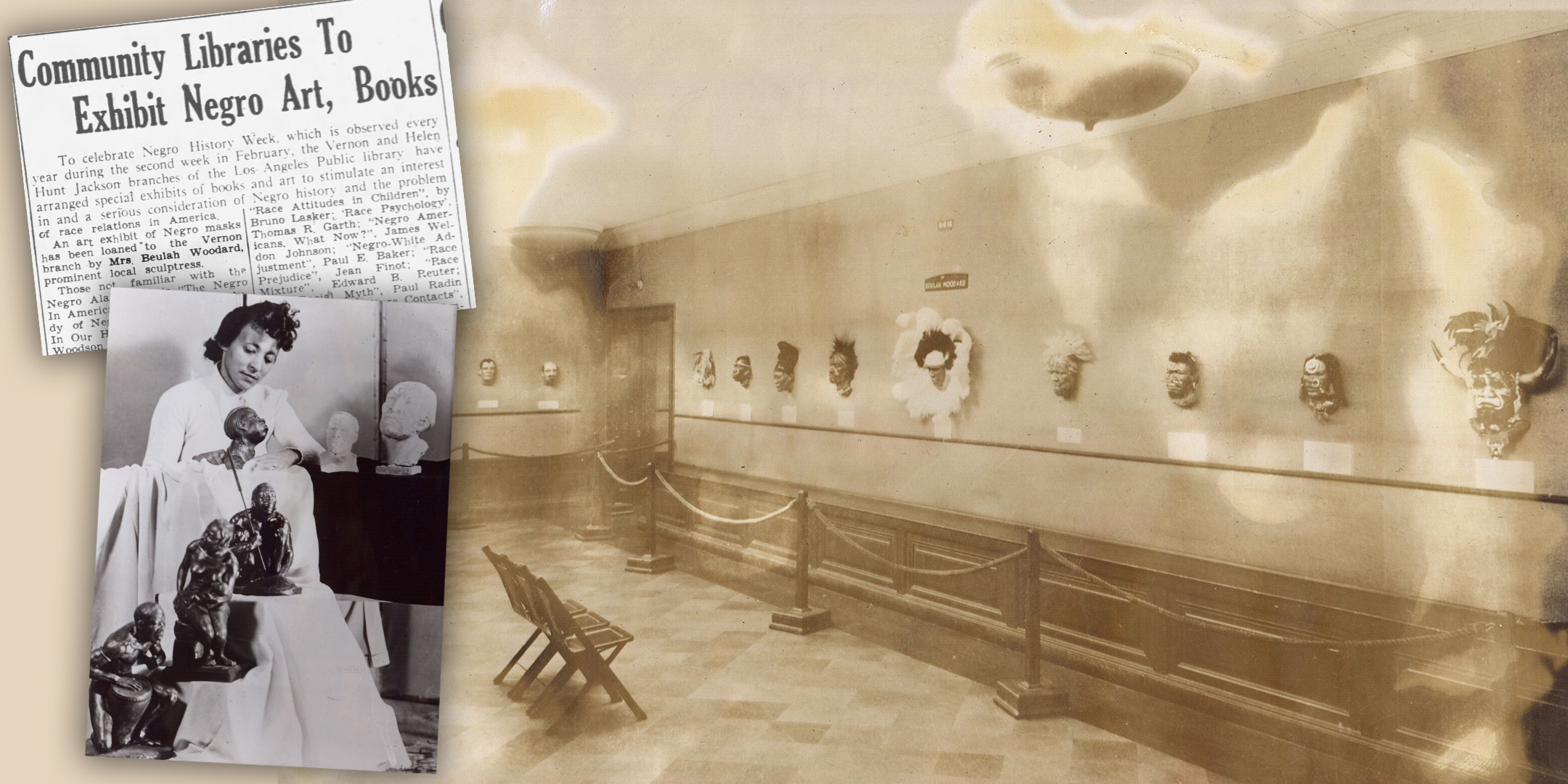
Music was just one of the art forms that thrived near the Vernon Library. The Vernon Carnegie was the site of the first traveling exhibit by the California Art Club in November 1915. The exhibit, hosted by the South Side Ebell Club (which was started by librarian Mary L. Hieber before the Carnegie Library was built), featured fifty paintings and sculptures by artists such as William Brandt and Julia Bracken Brandt (both of whom were library boosters who lived near the Lincoln Heights Branch), Donna M. Schuster, Hanson Puthuff, and Guy Rose.
Artist and sculptor Beulah Woodard lived near the library for years (her studio was behind her home) and exhibited her art at the branch while Miriam Matthews was the librarian. According to Women Artists of the Harlem Renaissance, Ms. Matthews saw sculptures created by Beulah Woodard in the window of the offices of California News, an African American newspaper on Central Avenue near 35th Street. The California Eagle lauded Ms. Woodard's October 1935 exhibit of 30 African masks at the Los Angeles County Museum of History, Science and Art. Some of the masks were loaned to Miriam Matthews and the Vernon Library during the February 1936 Negro History Week (the precursor to African American History Month). Her 1955 obituary in the California Eagle praised her combination of "genius for sculpture with painstaking research in African folklore."
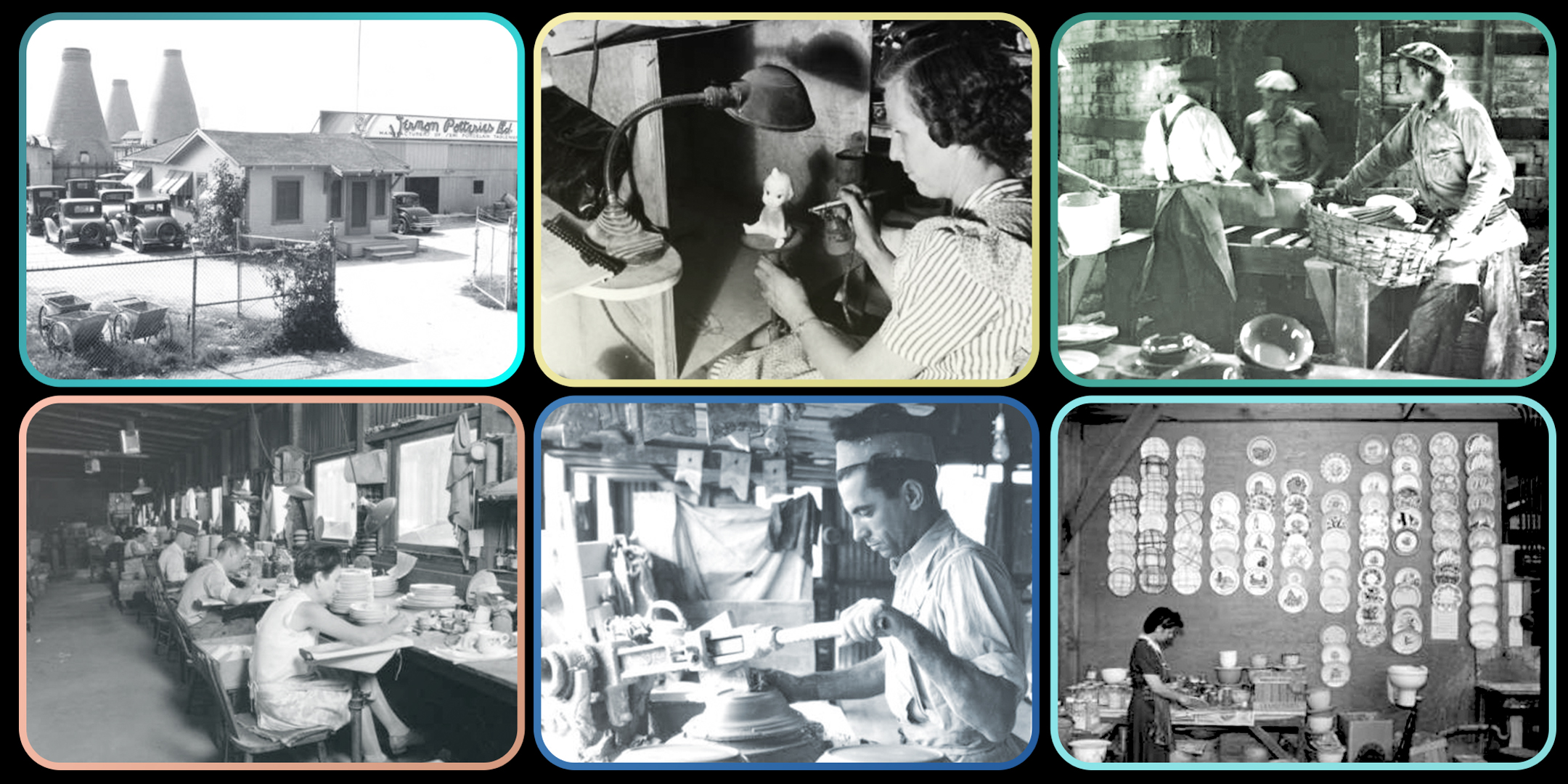
A day in the work of celebrated California pottery company Vernon Potteries (aka Vernon Kilns), located southeast of the library, was documented in 1931 and is part of the Los Angeles Public Library photo collection. The company was known for its pottery and dinnerware, with artists such as Rockwell Kent and Don Blanding contributing designs. They also made commemorative plates celebrating states, cities, and places, including Los Angeles' Farmers Market at 3rd and Fairfax and Knotts Berry Farm. Their pottery designs were hand painted or used in the transfer printing process. Maxine Feek Nelson's book, Collectible Vernon Kilns, describes the history of the location from its inception as Poxon Pottery in 1912 until Vernon Kilns closed their doors in 1958.
Sports
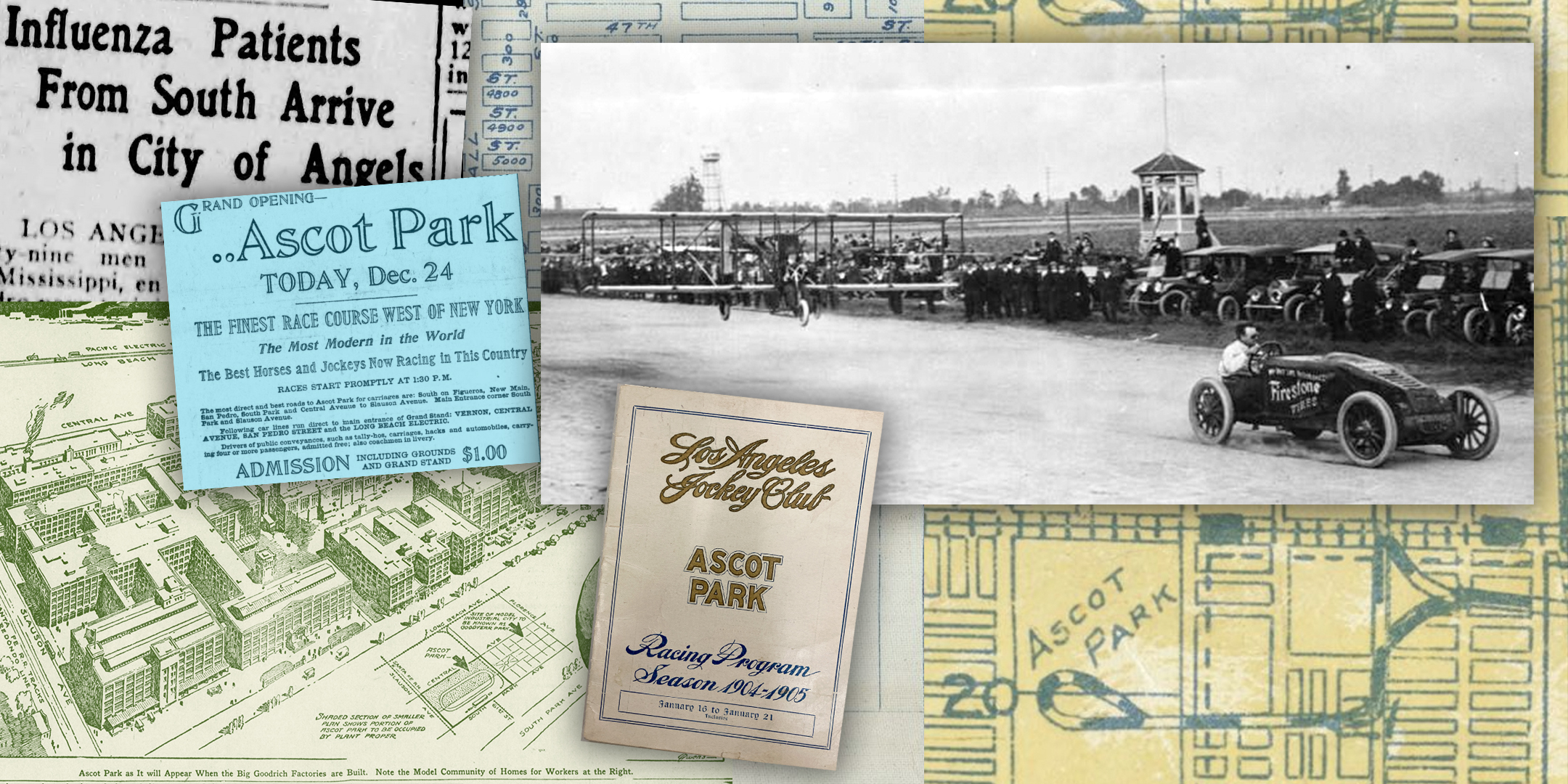
People traveled from all over Southern California, often by railway, to attend sporting events in the community. Ascot Park was a popular racetrack (the first of at least five Los Angeles County racing venues named Ascot according to Where They Raced Lap 2: Auto Racing Venues in Southern California, 1900-2000). It opened on December 24, 1903, on Slauson Avenue between Central Avenue and South Park Avenue (now called Avalon Blvd). Newspapers covered the horse, auto, and motorcycle races that took place there. They covered the racers–including Barney Oldfield, Wild Bob Burman, Edward Rickenbacker, and Louis Chevrolet–and their machines. (According to Rickenbacker's autobiography, a race at Ascot Park was the last the World War I flying ace ever drove.) Extreme sporting events at the time included a 24-hour auto race and, in response to the aviation craze, there were even exciting races between autos and planes. Aviation "matinees" (aka stunt flying), dirigibles, and hot air balloons visited Ascot Park as well. In February 1918, several newspapers touted that Ascot Park would be the site of the first women's auto race in the United States. The winner of that race, Mrs. C.H. Wolfelt, drove her Stutz to victory! In October 1918, Ascot Park was also used as a makeshift isolation hospital for some of the first Spanish influenza victims in Los Angeles. Ascot Park was sold in 1919 and destined to become a Goodyear rubber plant and cotton mill and featured nearby employee housing that was dubbed Goodyear Gardens. The last event at Ascot was a Wild West stampede held in April 1920. The grandstand was demolished and offered as free wood. The Goodyear plant that replaced it remained there for sixty years, closing in 1980. Reading digitized local newspapers available through the Los Angeles Public Library offers an exciting history of Los Angeles' first Ascot Park.
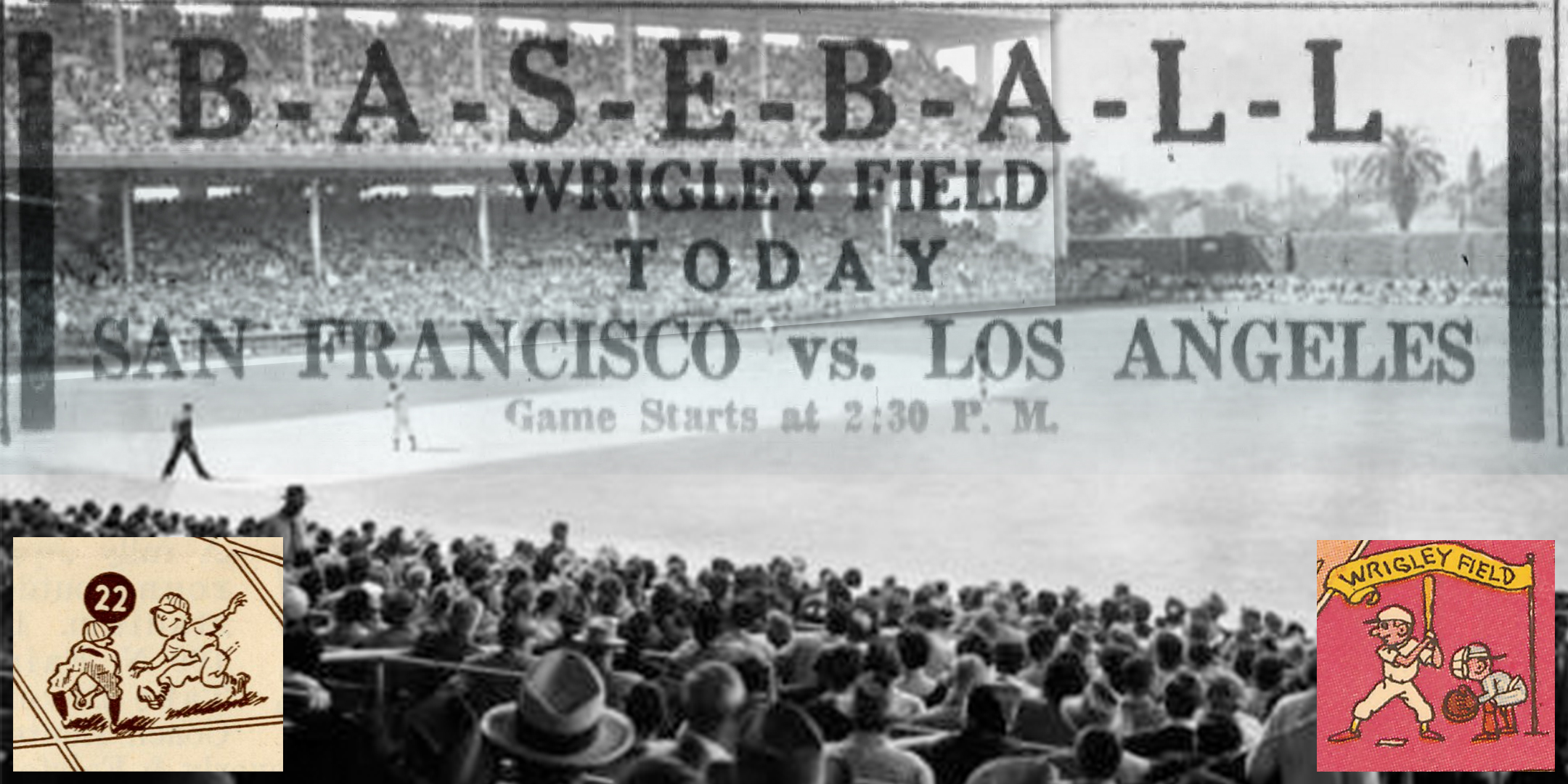
According to Endless Seasons: Baseball in Southern California, there were at least three Pacific Coast League ballparks located near the Vernon Branch. The most famous was Wrigley Field, owned by William K. Wrigley Jr. and designed by architect Zachary Taylor Davis (the designer of Chicago's Wrigley Field), which opened in September 1925. It was located between San Pedro Street, Avalon, and 41st and 42nd Place. Over the years, the ballpark hosted the Los Angeles Angels (of the Pacific Coast League) and the Hollywood Stars baseball teams. The ballpark was replaced by the Gilbert W. Lindsay Community Center in 1969.
Vernon
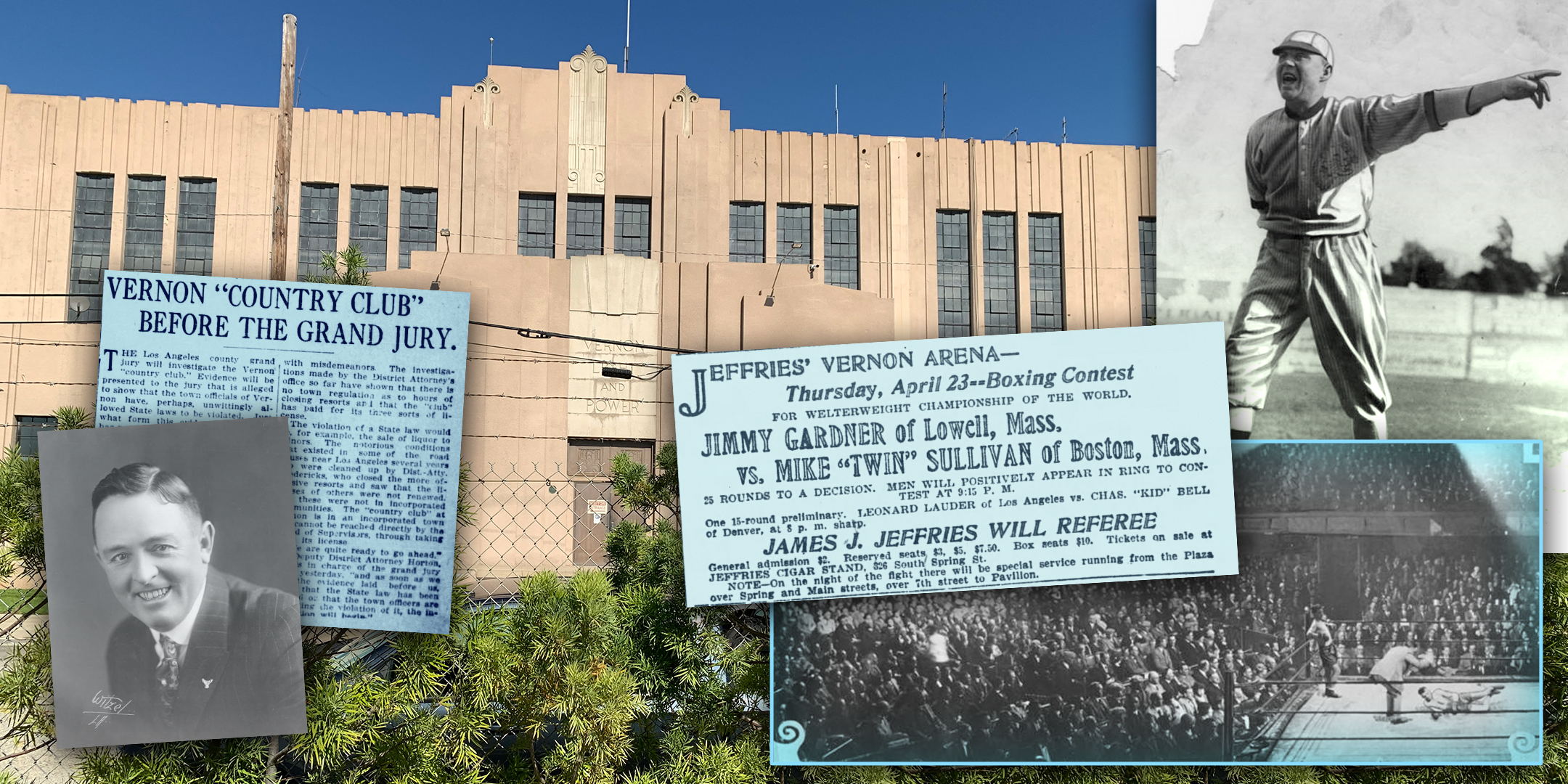
The nearby city of Vernon, incorporated in 1905 as an exclusively industrial city, became known in the early 20th century for popular sporting venues and nightlife with its free-flowing alcohol (flowing much more than in Los Angeles). Sports promoter Jack Doyle's Vernon Arena was a well-known destination at 38th Street and Santa Fe Avenue. The public and celebrities packed the arena for the famous Tuesday fight nights. Doyle also operated a boxing training camp and a huge bar (thirty+ bartenders worked the two 80-foot bartops of the establishment). Other popular Vernon spots included boxer Jim Jeffries' Vernon Arena, Baron Long's Vernon Country Club, and Maier Park, where the Vernon Tigers baseball team played. Check out The Iron Fist: The Immigrant Journey of J.B. Leonis to Riches and Power in Southern California or Leonis of Vernon to learn more about Vernon as a destination for amusements. For architectural history, don't miss Huell Howser's visit to the beautiful, and amazingly preserved, Art Deco Vernon Power and Light Plant.
More People and Places
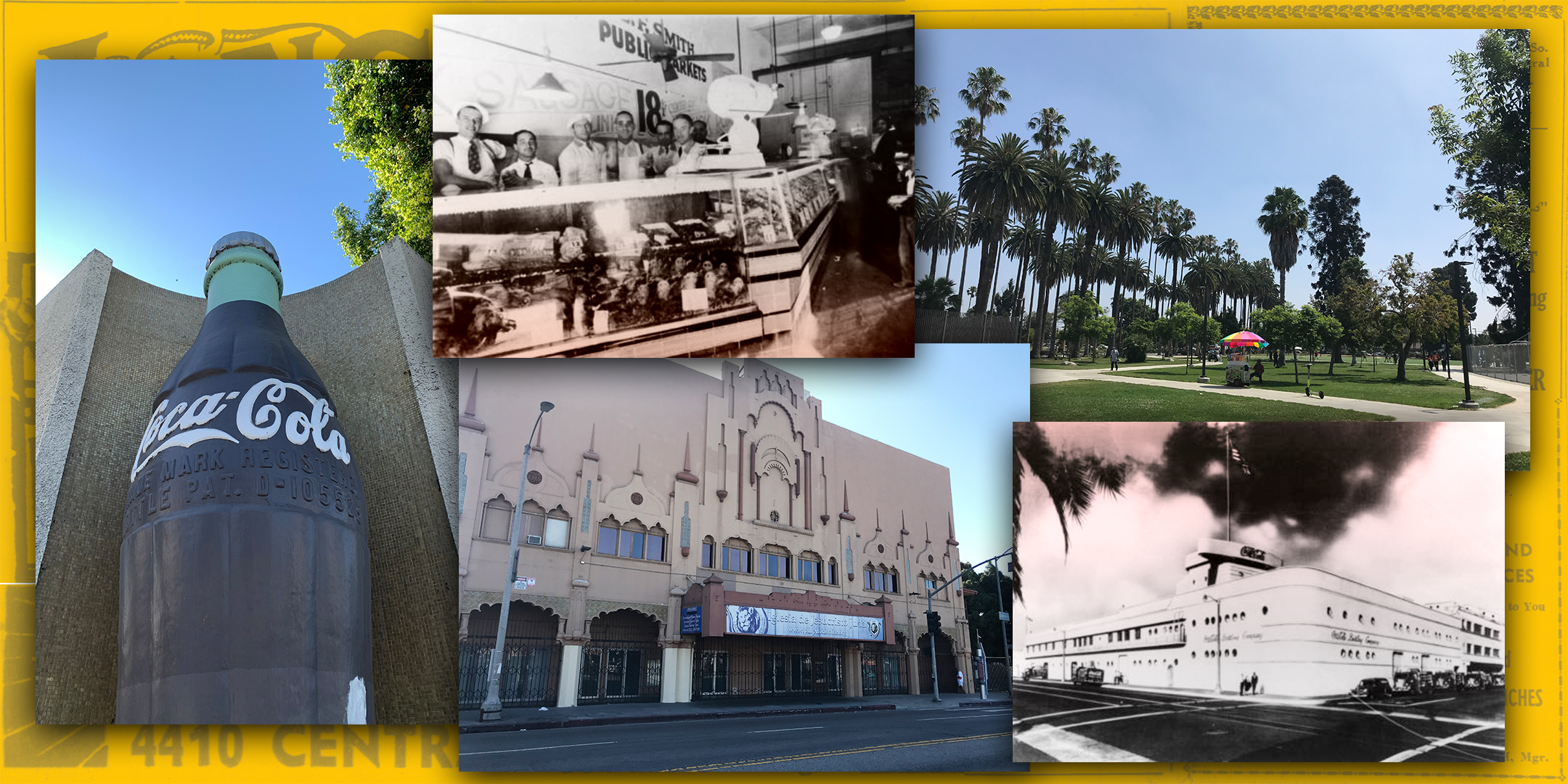
Besides the books, photos, and newspapers filled with information on the people and places near the library, one of the best resources for remembrance of the community is the HistoryMakers Digital Archive. HistoryMakers, available under the Education & Research tab on the library's website, is the largest African American video oral history archive in the United States. Musician Buddy Collette, former LAPD chief, and City Council member Bernard Parks are two interviewees who remember Central Avenue, Jefferson High School, the Dunbar Hotel, and Wrigley Field. And don't miss Philip Hart discussing William J. Powell, the Bessie Coleman Aero Club, and African American aviators in Los Angeles. Another important resource for learning about Central Avenue businesses and community members is the 1930-31 Los Angeles Negro City Directory and Who's Who. The directory was created at great effort by the California Eagle Publishing Company, and a digitized version is available through the Los Angeles Public Library. Many well-known Angelenos lived near the library at some point in their lives. In addition to the Jefferson High School-attending musicians named earlier, artist Beulah Woodard, and librarian Miriam Matthews, other Angelenos who lived near the library include composer William Grant Still, dancer and choreographer Carmen de Lavallade, musician and composer Edward "Kid" Ory, diplomat Ralph Bunche, composer and radio host A.C. Bilbrew, and Dr. Ruth Temple (the first female African American doctor in Los Angeles).
There are many more beautiful buildings and historically significant places to explore near the library. The nearby 28th Street YMCA and the Second Baptist Church, both designed by architect Paul R. Williams, are on the Los Angeles Historic-Cultural Landmarks list and the National Register of Historic Places. Also nearby are the first location built by the Golden State Mutual Life Insurance (a beautiful two-story Spanish Colonial Revival which stands at 4261 S. Central), the 27th Street Historic District, and the 52nd Place Historic District, all of which are on the National Register of Historic Places. Early twentieth-century guidebooks of Los Angeles also point out the beauty of South Park, a city park that was created in 1899. The park, named to complement the East Los Angeles Park (now Lincoln Park) and Westlake Park (now MacArthur Park) that already existed, can still be entered through its palm tree-lined walkway on Avalon (formerly South Park Avenue) and E. 50th Street. This blog post describes a small portion of local history to be found within approximately a two-mile radius of the Vernon - Leon H. Washington Jr. Memorial Branch–but many more stories can be found in the library's resources.
